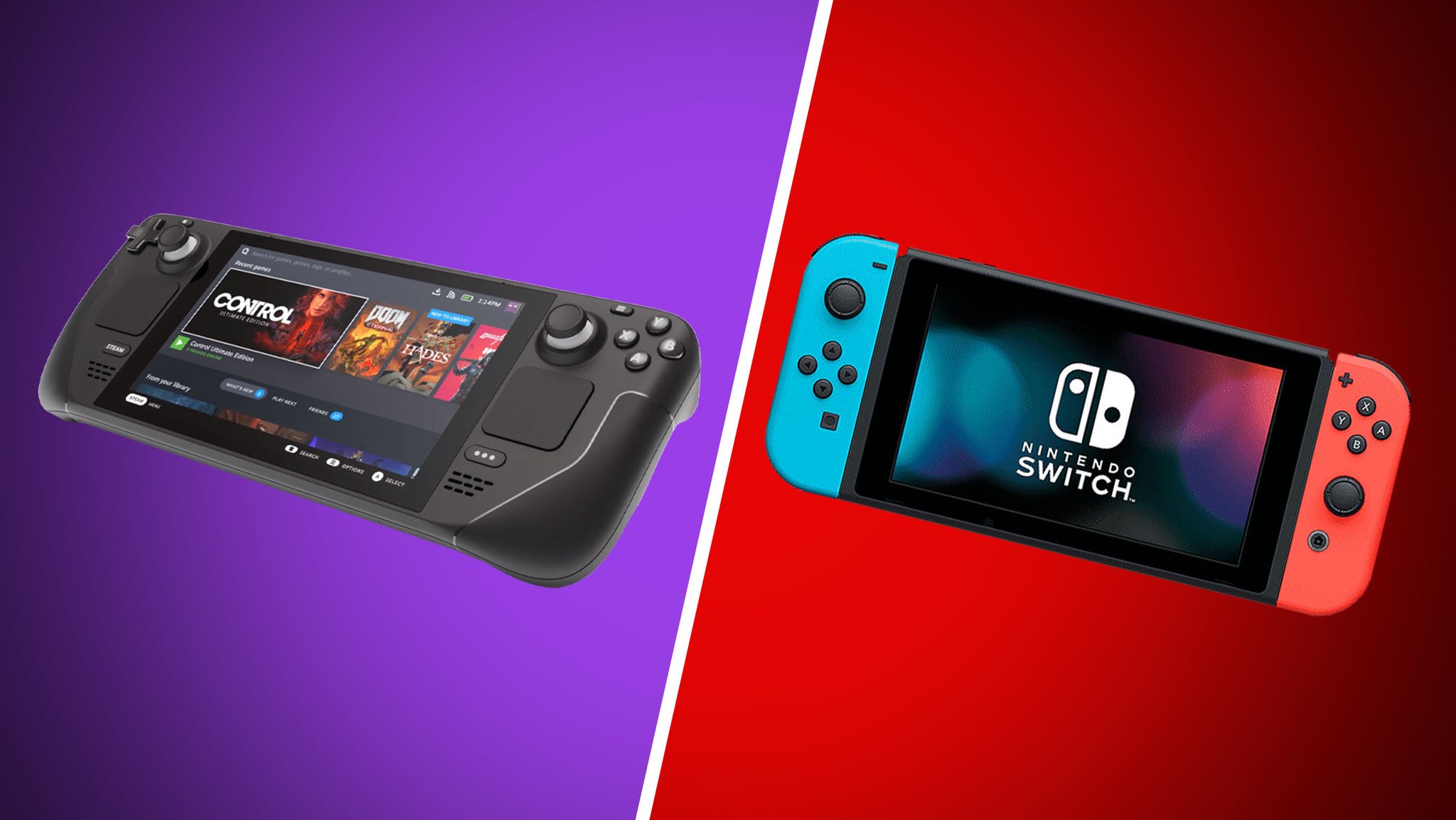New hardware
Steam Deck
Pros
- Impressive handheld specs
- Optional SSD storage
- Leverages Steam
- Access to PC library on Steam
Cons
- Higher-end models are expensive
- SteamOS means some games might not work
Valve's new Steam Deck handheld is pitched as a portable gaming PC. It packs the hardware to accomplish that and in theory, gives players access to every game they own on Steam. There's even optional SSD storage, for a higher price.
Tried and true
Nintendo Switch OLED model
Pros
- Nintendo Switch exclusive games
- Cheaper price
- Joy-cons provide alternate play options
- OLED screen
Cons
- Weaker specs
- Few improvements over existing Nintendo Switch
The Nintendo Switch OLED model is a revision of the Nintendo Switch. While it doesn't pack more impressive specs, the OLED screen will improve the colors in some games, while improved kickstand means easier portable play.
It's a great time for handheld gaming, with a couple of different options for anyone interested in jumping in right now. Valve has made a bold entrance with the announcement of the Steam Deck, while Nintendo continues revising its current hardware with the Nintendo Switch OLED model. Outside of the obvious similarities, there's some key differences prospective buyers should be aware of. We've rounded up the most important information regarding both systems.
Steam Deck vs. Nintendo Switch OLED model: Hardware
When it comes to the Steam Deck tech specs and the what's new with the Nintendo Switch OLED model, there's a pretty stark contrast. The Steam Deck has some decently capable hardware while the Nintendo Switch OLED model is essentially just a revision of the original Nintendo Switch that launched back in March 2017. You can check out the specs of both below.
| Steam Deck | Nintendo Switch OLED model | |
|---|---|---|
| Display | 7-inch LCD (diagonal), 1200x800 px | 7-inch OLED, 1280x720 px |
| Processor | AMD APU, Zen 2 4c/8t, 2.4-3.5GHz | AMD APU, ARM quad-core, 1.02 GHz |
| Graphics | 8 RDNA 2 CUs, 1.0-1.6GHz | NVIDIA Tegra X1, 307.2-768 MHz |
| Memory | 16GB LPDDR5 RAM | 4GB LPDDR4 SDRAM |
| Storage | 64GB eMMC/256GB SSD/512GB SSD | 64GB eMMC |
| Expandable storage | Yes, microSD card slot | Yes, microSD card slot |
| Bluetooth | Bluetooth 5.0 | Controllers only |
| Wi-Fi | Dual-band Wi-Fi radio, 2.4GHz and 5GHz | Dual-band Wi-Fi radio, 2.4GHz and 5GHz |
| Headphone jack | 3.5mm stereo headphone/headset jack | 3.5mm stereo headphone/headset jack |
| Charging input | 45W USB Type-C PD3.0 power supply | USB-C |
| Battery | 40Whr battery, 2-8 hours of gameplay | Roughly 4.5-9 hours |
| Dimensions | 11.7 x 4.6 x 1.9 inches | 4 x 9.5 x 0.55 inches |
| Weight | 1.47 pounds (669 grams) | 0.93 pounds (422 grams) |
Overall, the Steam Deck should be capable of running newer games with more ease, with the option of more, faster storage through the optional SSD models. On the flip side, it doesn't have an OLED screen, meaning colors may not pop the same way as on the Nintendo Switch OLED model, which also has a slightly better battery, though this will be very case by case depending on the game.
It's also worth mentioning that the top tier and priciest version of the Steam Deck includes "premium anti-glare etched glass," however Valve has not opted to provide any details beyond that. This is also the only physical difference in the different versions of the Steam Deck outside of storage space, as the GPU/CPU and other important components are identical.
Steam Deck vs. Nintendo Switch OLED model: Games
Where these systems diverge dramatically is in the games. The Steam Deck uses SteamOS, meaning players can, in theory, access their full Steam library with some of the best PC games available. Want to take Baldur's Gate 3 on the go? Now you can. There's an important caveat however, in just how it works. The Steam Deck uses Proton, a compatibility layer that "translates" Windows games to run on Linux. Some games won't function with Proton however and others may run but will encounter issues.
The Nintendo Switch OLED model is fairly straightforward, offering the exact same library available on other Nintendo Switch units, with the best Nintendo Switch games mixed with a wide range of third-party and indie support.
Steam Deck vs. Nintendo Switch OLED model: Price and release date
The Nintendo Switch OLED model will be available for $350, a $50 increase over the regular Nintendo Switch. Meanwhile, the base model for the Steam Deck is $400. Higher-end versions are available at $529 and $649, which include a 256GB and 512GB SSD, respectively. Obviously, there's a huge disparity if you go for the top versions but at the base level, the Steam Deck and Nintendo Switch OLED model have just a $50 difference.
The Steam Deck is expected to begin shipping in December 2021, with some orders taking a little longer and more opening up at some point in 2022. The Nintendo Switch OLED model is set to release on Oct. 8, 2021, which is the same release date of the upcoming Metroid Dread.
Something new
Steam Deck
Portable PC at a price
The Steam Deck packs the right hardware to make taking your Steam library anywhere you want a real possibility. You'll have to open your wallet if you really want space for plenty of games though.
Just a revision
Nintendo Switch OLED model
Experience Nintendo's full library
Outside of an OLED screen that can provide richer colors, this model Nintendo Switch offers minimal improvements. It's still cheaper than a Steam Deck though, with a proven lineup of exclusive software.




No comments: